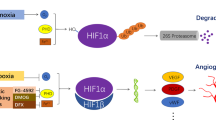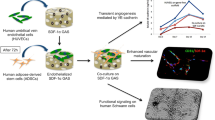No Heading
Purpose.
The primary challenge for tissue engineering is to develop a vascular supply that can support the metabolic needs of the engineered tissues in an extracellular matrix. In this study, the feasibility of using a natural compound, ginsenoside Re, isolated from Panax ginseng in stimulating angiogenesis and for tissue regeneration was evaluated.
Methods.
Effects of ginsenoside Re on the proliferation, migration, and tube formation of human umbilical vein endothelial cells (HUVECs) were examined in vitro. Additionally, angiogenesis and tissue regeneration in a genipin-fixed porous acellular bovine pericardium (extracellular matrix; ECM) incorporated with ginsenoside Re implanted subcutaneously in a rat model were investigated. Basic fibroblast growth factor (bFGF) was used as a control.
Results.
It was found that HUVEC proliferation, migration in a Transwell plate, and tube formation on Matrigel were all significantly enhanced in the presence of bFGF or ginsenoside Re. Additionally, effects of ginsenoside Re on HUVEC proliferation, migration, and tube formation were dose-dependent and reached a maximal level at a concentration of about 30 μg/ml. The in vivo results obtained at 1 week postoperatively showed that the density of neocapillaries and the tissue hemoglobin content in the ECMs were significantly enhanced by bFGF or ginsenoside Re. These results indicated that angiogenesis in the ECMs was significantly enhanced by loading with bFGF or ginsenoside Re. At 1 month postoperatively, vascularzied neo-connective-tissue fibrils were found to fill the pores in the ECMs loaded with bFGF or ginsenoside Re.
Conclusions.
The aforementioned results indicated that like bFGF, ginsenoside Re-associated induction of angiogenesis enhanced tissue regeneration, supporting the concept of therapeutic angiogenesis in tissue-engineering strategies.
Similar content being viewed by others
Abbreviations
- bFGF:
-
basic fibroblast growth factor
- ECM:
-
extracellular matrix
- ECM/bFGF:
-
the ECM loaded with bFGF
- ECM/control:
-
the ECM dip-coated in the drug-free gelatin solution
- ECM/Re:
-
the ECM loaded with ginsenoside Re
- H&E:
-
hematoxylin and eosin
- HUVEC:
-
human umbilical vein endothelial cell
- MTS:
-
3-(4,5-dimethylthiazol-2-yl)-5-(3-carboxymethoxyphenyl)-2-(4-sulfophenyl)-2H-tetrazolium
- MTT:
-
3-(4,5-dimethylthiazol-2-yl)-2,5-diphenyl tetrazolium bromide
- NO:
-
nitric oxide
- NOS:
-
nitric oxide synthase
- PBS:
-
phosphate buffered saline
References
1. L. G. Griffith and G. Naughton. Tissue engineering: current challenges and expanding opportunities. Science 295:1009–1014 (2002).
2. P. Carmeliet and R. K. Jain. Angiogenesis in cancer and other diseases. Nature 407:249–257 (2000).
3. C. K. Colton. Implantable biohybrid artificial organs. Cell Transplant 4:415–436 (1995).
4. M. K. Smith, M. C. Peters, T. P. Richardson, J. C. Garbern, and D. J. Mooney. Locally enhanced angiogenesis promotes transplanted cell survival. Tissue Eng. 10:63–71 (2004).
5. L. D. Shea, E. Smiley, J. Bonadio, and D. J. Mooney. DNA delivery from polymer matrices for tissue engineering. Nat. Biotechnol. 17:551–554 (1999).
6. K. Y. Lee, C. R. Halberstadt, W. D. Holder, and D. J. Mooney. Breast reconstruction, In: R. P. Lanza, R. Langer, and J. Vacanti, (eds), Principles of Tissue Engineering. Academic Press, New York, 2000, pp. 409–423
7. Y. Tabata. Tissue regeneration based on growth factor release. Tissue Eng. 9:S5–S15 (2003).
8. R. Y. K. Chan, W. F. Chen, A. Dong, D. Guo, and M. S. Wong. Estrogen-like activity of ginsenoside-Rg1 derived from panax notoginseng. J. Clin. Endocrinol. Metab. 87:3691–3695 (2002).
9. A. S. Attele, J. A. Wu, and C. S. Yuan. Ginseng pharmacology multiple constituents and multiple actions. Biochem. Pharmacol. 58:1685–1693 (1999).
10. N. Morisaki, S. Watanabe, M. Tezuka, M. Zenibayashi, R. Shiina, N. Koyama, T. Kanzaki, and Y. Saito. Mechanism of angiogenic effects of saponin from Ginseng Radix rubra in human umbilical vein endothelial cells. Br. J. Pharmacol. 115:1188–1193 (1995).
11. G. I. Scott, P. B. Colligan, B. H. Ren, and J. Ren. Ginsenosides Rb1 and Re decrease cardiac contraction in adult rat ventricular myocytes: role of nitric oxide. Br. J. Pharmacol. 134:1159–1165 (2001).
12. Z. Q. Jin and C. M. Liu. Effect of ginsenoside Re on the electrophysiological activity of the heart. Planta Med. 60:192–193 (1994).
13. Z. Q. Jin. The action of ginsenoside Re on inotropy and chronotropy of isolated atria prepared from guinea pigs. Planta Med. 62:314–316 (1996).
14. S. Babaei and D. J. Stewart. Overexpression of endothelial NO synthase induces angiogenesis in a co-culture model. Cardiovas. Res. 55:190–200 (2002).
15. Y. Chang, C. C. Tsai, H. C. Liang, and H. W. Sung. In vivo evaluation of cellular and acellular bovine pericardia fixed with a naturally occurring crosslinking agent (genipin). Biomaterials 23:2447–2457 (2002).
16. K. A. Hotchkiss, A. W. Ashton, R. Mahmood, R. G. Russell, J. A. Sparano, and E. L. Schwartz. Inhibition of endothelial cell function in vitro and angiogenesis in vivo by docetaxel (Taxotere): association with impaired repositioning of the microtubule organizing center. Mol. Cancer Ther. 1:1191–1200 (2002).
17. Y. Terai, M. Abe, K. Miyamoto, M. Koike, M. Yamasaki, M. Ueda, M. Ueki, and Y. Sato. Vascular smooth muscle cell growth-promoting factor/F-Spondin inhibits angiogenesis via the blockade of integrin αvβ3 on vascular endothelial cells. J. Cell. Physiol. 188:394–402 (2001).
18. H. Sakamoto, T. Mashima, A. Kizaki, S. Dan, Y. Hashimoto, M. Naito, and T. Tsuruo. Glyoxalase I is involved in resistance of human leukemia cells to antitumor agent-induced apoptosis. Blood 95:3214–3218 (2000).
19. F. Facchiano, A. Lentini, V. Fogliano, S. Mancarella, C. Rossi, A. Facchiano, and M. C. Capogrossi. Sugar-induced modification of fibroblast growth factor 2 reduces its angiogenic activity in vivo. Am. J. Pathol. 161:531–541 (2002).
20. D. E. Morales, K. A. McGowan, D. S. Grant, S. Maheshwari, D. Bhartiya, M. C. Cid, H. K. Kleinman, and H. W. Schnaper. Estrogen promotes angiogenic activity in human umbilical vein endothelial cells in vitro and in a murine model. Circulation 91:755–763 (1995).
21. O. H. Lee, Y. M. Kim, Y. M. Lee, E. J. Moon, D. J. Lee, J. H. Kim, K. W. Kim, and Y. G. Kwon. Sphingosine 1-phosphate induces angiogenesis: its angiogenic action and signaling mechanism in human umbilical vein endothelial cells. Biochem. Biophys. Res. Commun. 264:743–750 (1999).
22. K. M. Malinda, L. Ponce, H. K. Kleinman, L. M. Shackelton, and A. J. T. Millis. Gp38k, a protein synthesized by vascular smooth muscle cells, stimulates directional migration of human umbilical vein endothelial cells. Exp. Cell Res. 250:168–173 (1999).
23. D. W. Courtman, C. A. Pereira, V. Kashef, and D. MicComb. Development of a pericardial acellular matrix biomaterial: Biochemical and mechanical effects of cell extraction. J. Biomed. Mater. Res. 28:655–666 (1994).
24. Y. Chang, M. H. Lee, H. C. Liang, C. K. Hsu, and H. W. Sung. Acellular bovine pericardia with distinct porous structures fixed with genipin as an extracellular matrix. Tissue Eng. 10:881–892 (2004).
25. H. W. Sung, Y. Chang, C. T. Chiu, C. N. Chen, and H. C. Liang. Crosslinking characteristics and mechanical properties of a bovine pericardium fixed with a naturally occurring crosslinking agent. J. Biomed. Mater. Res. 47:116–126 (1999).
26. I. Martin, V. P. Shastri, R. F. Padera, J. Yang, A. J. Mackay, R. Langer, G. Vunjak-Novakovic, and L. E. Freed. Selective differentiation of mammalian bone marrow stromal cells cultured on three-dimensional polymer foams. J. Biomed. Mater. Res. 55:229–235 (2001).
27. J. S. Pieper, T. Hafmans, P. B. van Wachem, M. J. A. van Luyn, L. A. Brouwer, J. H. Veerkamp, and T. H. van Kuppevelt. Loading of collagen-heparan sulfate matrices with bFGF promotes angiogenesis and tissue generation in rats. J. Biomed. Mater. Res. 62:185–194 (2002).
28. D. W. Courtman, B. F. Errett, and G. J. Wilson. The role of crosslinking in modification of the immune response elicited against xenogenic vascular acellular matrices. J. Biomed. Mater. Res. 55:576–586 (2001).
29. S. J. Bryant and K. S. Anseth. Controlling the spatial distribution of ECM components in degradable PEG hydrogels for tissue engineering cartilage. J. Biomed. Mater. Res. 64A:70–79 (2003).
30. A. Bader, T. Schiling, and O. E. Teebken. Tissue engineering of heart valves-human endothelial cell seeding of detergent acellularized porcine valves. Euro. J. Cardio. Thoracic. Sur. 14:279–284 (1998).
31. Y. Tabata, M. Miyao, M. Yamamoto, and Y. Ikada. Vascularization into a porous sponge by sustained release of basic fibroblast growth factor. J. Biomater. Sci. Polymer Edn. 10:957–968 (1999).
32. F. Esch, A. Baird, N. Ling, N. Ueno, F. Hill, L. Denoroy, R. Klepper, D. Gospodarowicz, P. Bohlen, and R. Guillemin. Primary structure of bovine pituitary basic fibroblast growth factor (FGF) and comparison with the amino-terminal sequence of bovine brain acidic FGF. Proc. Natl. Acad. Sci. USA 82:6507–6511 (1985).
33. D. B. Rifkin and D. Moscatelli. Structural characterization and biological functions of basic fibroblast growth factor. J. Cell Biol. 109:1 (1989).
34. D. S. Grant, P. I. Lelkes, K. Fukuda, and H. K. Kleinman. Intracellular mechanisms involved in basement membrane induced blood vessel differentiation in vitro. In Vitro Cell. Dev. Biol. 27A:327–336 (1991).
35. M. C. Kibbey, L. S. Royce, M. S. Dym, B. J. Baum, and H. K. Kleinman. Glandular morphogenesis of a human submandibular cell line by basement membrane components in vitro. Exp. Cell Res. 198:343–357 (1992).
36. K. A. Seely and J. Aggeler. Modulation of milk protein synthesis through alteration of the cytoskeleton in mouse mammary epithelial cells cultured on a reconstituted basement membrane. J. Cell. Physiol. 146:117–130 (1991).
37. M. Taub, Y. Wang, T. M. Szcesney, H. K. Kleinman, and G. R. Martin. Transforming growth factor alpha is required for kidney tubulogenesis in Matrigel cultures in serum-free medium. Proc. Natl. Acad. Sci. USA 87:4002–4006 (1990).
38. M. Presta, M. Beller, A. Vecchi, J. Hesselgesser, A. Mantovani, and R. Horuk. Noncompetitive, chemokine-mediated inhibition of basic fibroblast growth factor-induced endothelial cell proliferation. J. Biol. Chem. 273:7911–7919 (1998).
39. S. Sengupta, S. A. Toh, L. A. Sellers, J. N. Skepper, P. Koolwijk, H. W. Leung, H. W. Yeung, R. N. S. Wong, R. Sasisekharan, and T. P. Fan. Modulating angiogenesis: the yin and the yang in ginseng. Circulation 110:1219–1225 (2004).
40. T. Matsuda and Y. Nakayama. Surface microarchitectural design in biomedical applications: In vitro transmural endothelialization on microporous segmented polyurethane films fabricated using an excimer laser. J. Biomed. Mater. Res. 31:235–242 (1996).
41. S. Fujikawa, T. Yokota, K. Koga, and J. Kumada. The continuous hydrolysis of geniposide to genipin using immobilized β-glucosidase on calcium alginate gel. Biotechnol. Lett. 9:697–702 (1987).
42. T. H. Tsai, J. Westly, T. F. Lee, and C. F. Chen. Identification and determination of geniposide, genipin, gardenoside, and geniposidic acid from herbs by HPLC/photodiode-array detection. J. Liq. Chromatogr. 17:2199–2205 (1944).
43. T. Akao, K. Kobashi, and M. Aburada. Enzymatic studies on the animal and intestinal bacterial metabolism of geniposide. Biol. Pharm. Bull. 17:1573–1576 (1994).
44. H. W. Sung, R. N. Huang, L. L. H. Huang, C. C. Tsai, and C. T. Chiu. Feasibility study of a natural crosslinking reagent for biological tissue fixation. J. Biomed. Mater. Res. 42:560–567 (1998).
45. H. W. Sung, I. L. Liang, C. N. Chen, R. N. Huang, and H. F. Liang. Stability of a biological tissue fixed with a naturally occurring crosslinking agent (genipin). J. Biomed. Mater. Res. 55:538–546 (2001).
46. A. Perets, Y. Baruch, F. Weisbuch, G. Shoshany, G. Neufeld, and S. Cohen. Enhancing the vascularization of three-dimensional porous alginate scaffolds by incorporating controlled release basic fibroblast growth factor microspheres. J. Biomed. Mater. Res. 65A:489–497 (2003).
47. F. C. Westal, R. Rubin, and D. Gospodarowicz. Brain derived fibroblast growth factor: A study of its inactivation. Life Sci. 33:2425–2429 (1983).
Author information
Authors and Affiliations
Corresponding author
Rights and permissions
About this article
Cite this article
Huang, YC., Chen, CT., Chen, SC. et al. A Natural Compound (Ginsenoside Re) Isolated from Panax ginseng as a Novel Angiogenic Agent for Tissue Regeneration. Pharm Res 22, 636–646 (2005). https://doi.org/10.1007/s11095-005-2500-3
Received:
Accepted:
Published:
Issue Date:
DOI: https://doi.org/10.1007/s11095-005-2500-3




